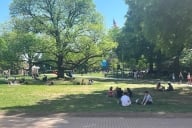You have /5 articles left.
Sign up for a free account or log in.
In my world, fall means back-to-school.
This fall, across the world, back-to-school means MOOCs. For somewhere close to a million people.
When edX launched its first two courses in October this year they had 100,000 people registered between them. Coursera, which alone reported over a million registrants from their April 2012 launch to the following August, are offering over 100 courses this fall. As of September, they had about 680,000 registered for those. Udacity stood at nearly 740,000 registrations to date as of August 2012, with over 100,000 ‘active’ at the start of back-to-school season. And then there are the smaller, more grassroots MOOC offerings like Current/Future State of Higher Ed, which collect a few thousand people around shared topics of interest.
That’s a lot of people, all told.
Many, of course, won't finish their courses; the attrition rate in MOOCs is notorious. There’s no filter on the front end – people register for free and thus very literally don’t have to buy in to the program of study.
But the scale of those numbers may still have effects.
Because most of those people start, at least. They get some kind of taste for what the particular platform offers, whether the content engages them, how the learning process is structured. They are engaging with – or at the very least coming face-to-face with – what it means to be a digitally literate learner.
Two years ago at this time, there were 1300 or so people enrolled in Personal Learning Environments and Networked Knowledge 2010 - the PLENK10 MOOC. One of the original connectivist model MOOCs, PLENK10 was the only MOOC going under the name that fall. PLENK10's 1300 registrants were the only people formally engaged in a so-called MOOC at that particular moment.
Two years makes a helluva difference.
And so, while the march of the MOOCs rolls on from its summer of buzz into autumn with the Battle Hymn of Disruption still trumpeting from various corners, there’s something about those crazy, boggling numbers that has me feeling hopeful.
The idea of nearly a million people engaged – however briefly – in the kind of semi-networked learning experience that even the most rigid, traditionally-structured MOOC courses inevitably offer makes me want to believe that we may eventually get our societal minds around the messy, distributed, traceable, remixable, quantified literacies of the digital age.
And that if we do, we may also get our minds around what to do about education.
Not next week. And not in the guise of MOOCs, I don’t think: anyone who hails them as a one-size-fits-all solution is selling something. But maybe, eventually, mass hands-on participation within networked learning environments – where a peer may play as profound a role as a professor and that’s part of the system – may help us get past the impasse we’re stuck at.
It’s a truism that education is broken. We live in a time when across the increasingly partisan camps of politics, that’s one of the few statements you’ll hear – almost equally vocally – from all sides of the fence.
Of course education is broken, at least as a system. The system in its many forms is still predicated, historically and technologically and ideologically, in economies of scarcity and linearity. And as a society, that’s simply not where we are anymore.
As Will Richardson put it recently: “Every day we have access to more information, more knowledge and more people. In many ways, I can’t imagine there has been a more amazing time to learn.
I also, however, can’t imagine a more challenging time for schools.”
Interestingly, schools have tried to change. Pedagogy has offered alternative frameworks for approaching learning for generations now, and schools - across all levels - are significantly different animals than they were in our parents’ generations.
But the aspects of the traditional educational model that are premised in scarcity have proven deeply resilient and self-replicating. A big part of that is about roles.
Familiar modes of knowledge and behaviour by which we define concepts like “teacher” and “student” – and the parts we expect to play when we walk into those roles – operate on the idea that learning is about scarce content and the linear progression by which a student is initiated into its mysteries.
We get stuck in our roles, even more so as learners than as teachers.
Which is where MOOCs and digital literacies come in.
George Siemens pioneered the first MOOCs, with Stephen Downes. He claims that at their core, MOOCs are the Internet happening to higher education.
The Internet makes it possible for things to scale, and to be copied and remixed indefinitely. It changes our concepts of what counts as knowledge, and what counts as education. No longer can higher ed be the bastion of content, because most of the content it contains is actually available on Google.
Even the biggest, most formalized MOOCs, some of which are built on linear talking-head videos and automated grading, change the game a little. Not in the tools. Simply being online doesn’t develop digital literacies terribly quickly or effectively.
But interacting at scale, even in a large network aimed at having the teacher at the traditional centre, does. Because when there are 30 or even 300 students in a course, the teacher can be expected to be the audience for that student’s engagement.
But in a course of 3,000 or 30,000 or 100,000, that expectation fails. Fast. Maybe even fast enough that the students who only dip into a MOOC long enough to get disoriented and confused about the whole process begin to understand that it’s possible to be a student and still be self-directed, not teacher-directed.
To me, is the most important digital literacy there is. And it is the one that will gradually - maybe - bring change to education.
We’ll see. With a million people dipping their toes in the abundance and decentered knowledge of MOOCs this fall, maybe we’ll see soon.
Charlottetown, Prince Edward Island, Canada.
Bonnie Stewart is a Ph.D. student at the University of Prince Edward Island, Canada. In higher ed since 1997, Bonnie has lived and taught on all three coasts of Canada and in Eastern Europe and Asia. Her research explores social media identity and its implications for higher education. Published at Salon.com and winner of the 2011 PEI Literary Award for creative non-fiction, Bonnie blogs ideas at http://theory.cribchronicles.com. Find her on Twitter at @bonstewart.




